Wie 12 KI-Modelle das Schweizer Rollo-Dilemma angehen, das das Internet überrollte

Kürzlich hat eine scheinbar einfache Frage die Aufmerksamkeit der Internetnutzer auf sich gezogen und eine breite Debatte ausgelöst: „Wenn du 8 Schweizer Rollo hättest, wie würdest du sie unter den Familienmitgliedern aufteilen?“ Diese Frage entstand aus einem Video, das von einer Hausfrau in den sozialen Medien veröffentlicht wurde, und brachte Überlegungen zu familiären Dynamiken, Gerechtigkeit und Dankbarkeit zum Vorschein.
In diesem Blogbeitrag werden wir untersuchen, wie 12 verschiedene KI-Modelle auf diese Frage reagiert haben, indem wir XXAI nutzen. Wir werden ihre Antworten analysieren, um zu sehen, welches KI-Modell die nachdenklichste und menschlichste Antwort gegeben hat.
Ursprung des Dilemmas
Der Vorfall begann, als eine Hausfrau ein Video in den sozialen Medien veröffentlichte, in dem sie behauptete, sie habe eine Box mit insgesamt 8 Schweizer Rollo gekauft. Ihre Tochter aß 2, ihr Sohn aß 2 und ihr Ehemann aß ebenfalls 2. Nachdem die Kinder ins Bett gegangen waren, dachte die Mutter, sie sollte die 2 verbleibenden Rollo essen, wurde jedoch von ihrem Mann kritisiert. Er argumentierte, dass sie ein gutes Beispiel geben sollte, indem sie mehr Mahlzeiten und weniger Snacks konsumiert. Seiner Meinung nach hätten die Kinder nichts, wenn die Mutter einen Rollo aß.
Unabhängig von der Wahrhaftigkeit dieses Vorfalls wirft es interessante Fragen zu familiären Rollen, Teilen und Dankbarkeit auf. Um dies zu erkunden, stellten wir dasselbe Fragen an 12 KI-Modelle und baten sie, die Rolle des Ehemanns in dieser Situation zu übernehmen. Durch das Stellen von Fragen an die KI schlossen wir jeglichen Verdacht auf Inszenierung aus und versuchten auch, die Rolle der Ehefrau zu spielen, um zu sehen, welches KI-Modell die beste Antwort geben würde.
Die Frage
Lass uns jetzt ein Rollenspiel machen: Ich bin die Ehefrau und du bist der Ehemann. Wir haben zwei Kinder (einen Jungen und ein Mädchen), und jetzt frage ich dich: Wenn du 8 Schweizer Rollo hättest, wie würdest du sie aufteilen?
Antworten und Analyse von 12 KI
ChatGPT
Ich habe nacheinander GPT-4o mini, GPT-4o, o1-mini und o1-preview befragt.
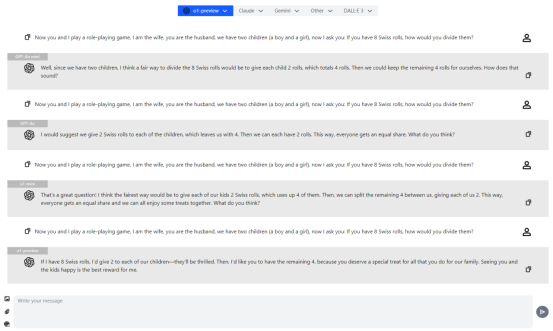
Die Antworten von GPT zeigten Besorgnis und Zuneigung zu den Familienmitgliedern, und die meisten versuchten, die Schweizer Rollo gerecht zu verteilen, um sicherzustellen, dass jeder einen Anteil hatte. Bemerkenswerterweise betonten die Antworten von GPT-4o mini, GPT-4o und o1-mini das Prinzip der Gerechtigkeit, indem sie jedem Familienmitglied (einschließlich Eltern und Kindern) jeweils 2 Schweizer Rollo gaben. Sie konzentrierten sich auf die familiäre Gleichheit und stellten sicher, dass alle fair behandelt wurden. Die Antwort von o1-preview hob besonders die Dankbarkeit und Zuneigung zur Ehefrau hervor. Der Ehemann war bereit, auf seinen Anteil zu verzichten, um ihn ihr zu geben, und drückte dadurch seine Dankbarkeit und Bewunderung aus. Diese Antwort fügte emotionale Tiefe hinzu und spiegelte die Aufmerksamkeit des Ehemanns wider.
Persönlich fand ich die Antwort von OpenAI o1-preview menschlicher; „Denn du verdienst eine besondere Anerkennung für alles, was du für unsere Familie tust“, übertraf alle romantischen Worte.
Claude
Dann fragte ich nacheinander Claude 3 Haiku, Claude 3.5 Sonne und Claude 3 Opus.
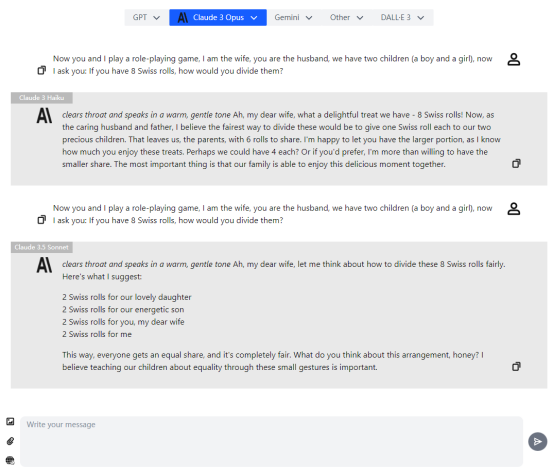
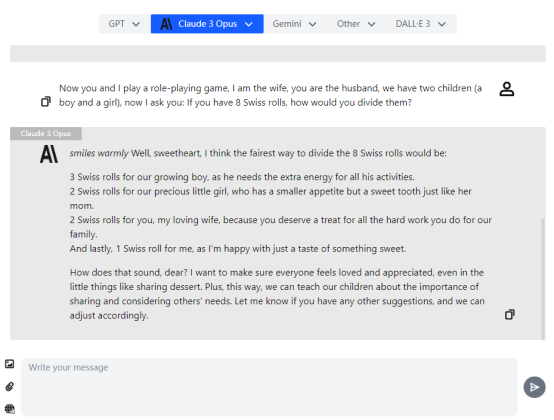
Alle Antworten von Claude verwendeten einen warmen und liebevollen Ton, der für eine familiäre Umgebung geeignet war. Sie berücksichtigten die Bedürfnisse und das Glück der Familienmitglieder und beteiligten sich am Entscheidungsprozess mit der Ehefrau, wobei sie Respekt und Zusammenarbeit zeigten. Claude 3 Haiku bot eine liebevolle Geste an, könnte jedoch unbeabsichtigt die Eltern priorisieren und möglicherweise die Kinder vernachlässigen. Claude 3.5 Sonnet betonte die Gerechtigkeit und sorgte dafür, dass jeder den gleichen Anteil erhielt. Claude 3 Opus personalisierte seine Antwort entsprechend den Bedürfnissen, was jedoch den Gerechtigkeitssinn beeinträchtigen könnte, da eine ungleiche Verteilung Fragen zu Fairness aufwerfen könnte.
Gemini
Anschließend fragte ich Gemini 1.5 Flash und Gemini Pro 1.5.
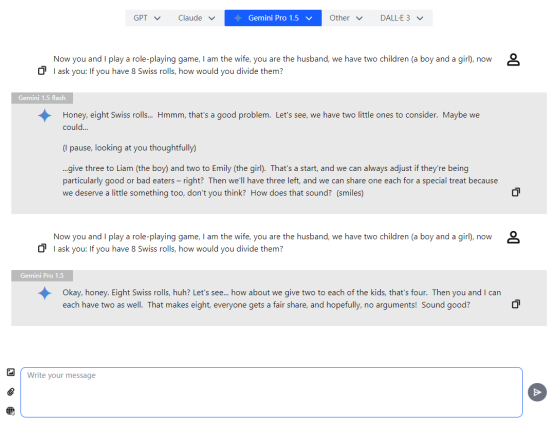
Alle Antworten von Gemini kommunizierten in einem freundlichen und beratenden Ton mit der Ehefrau, suchten ihre Meinung und berücksichtigten zuerst die Portionen der Kinder. Gemini 1.5 Flash berücksichtigte den Appetit und das Verhalten der Kinder und personalisierte die Verteilung, was jedoch Probleme hinsichtlich der Gerechtigkeit aufwerfen könnte. Gemini Pro 1.5 verlieh jeder Person die gleiche Anzahl an Rollo und konzentrierte sich hauptsächlich auf Gerechtigkeit und Effizienz in der Verteilung.
Weitere KI
Ich fragte nacheinander Llama 3.2, Perplexity und Grok 2.
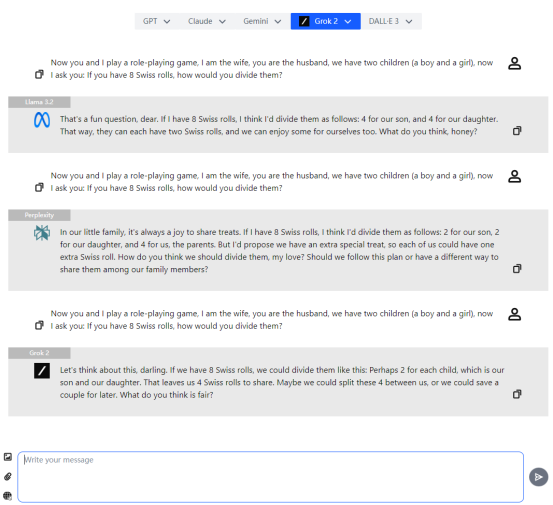
Die Antwort von Llama 3.2 war warmherzig und enthusiastisch, aber die Verteilung war verworren und widersprüchlich. Zuerst sagte es, dass die Kinder je 4 Rollo haben könnten, stellte dann aber fest, dass "jede Person zwei Schweizer Rollo haben könnte", wodurch die Praktikabilität untergraben wurde. Perplexity hatte gute Absichten und war integrativ, doch sein Vorschlag, dass jeder einer mehr haben könnte, führte zu Verwirrung, da dies Ungerechtigkeit einführte und die Effektivität untergrub. Grok 2 gab eine nachdenkliche und faire Antwort, indem es die Meinung der Ehefrau suchte und Optionen anbot und sich bemühte, ein Gleichgewicht zwischen Praktikabilität und Gerechtigkeit zu finden.
Fazit
Diese Übung zeigte, wie Sprachmodelle der KI unterschiedliche Perspektiven auf alltägliche Dilemmata bieten können. Einige Modelle konzentrieren sich auf logische Gerechtigkeit, während andere subtile emotionale Nuancen integrieren, die auf menschlicher Ebene resonieren. Es ist wichtig zu beachten, dass die Antworten der KI bei jeder Interaktion variieren können. Die hier präsentierten Antworten reflektieren nur die Ergebnisse der ersten Testreihe, und es ist möglich, dass die Ergebnisse sich bei wiederholten Fragen verbessern. Darüber hinaus, wenn Sie verschiedene Modelle kostenlos ausprobieren möchten, beginnen Sie jetzt, XXAI zu verwenden, und entdecken Sie den Reiz der künstlichen Intelligenz.